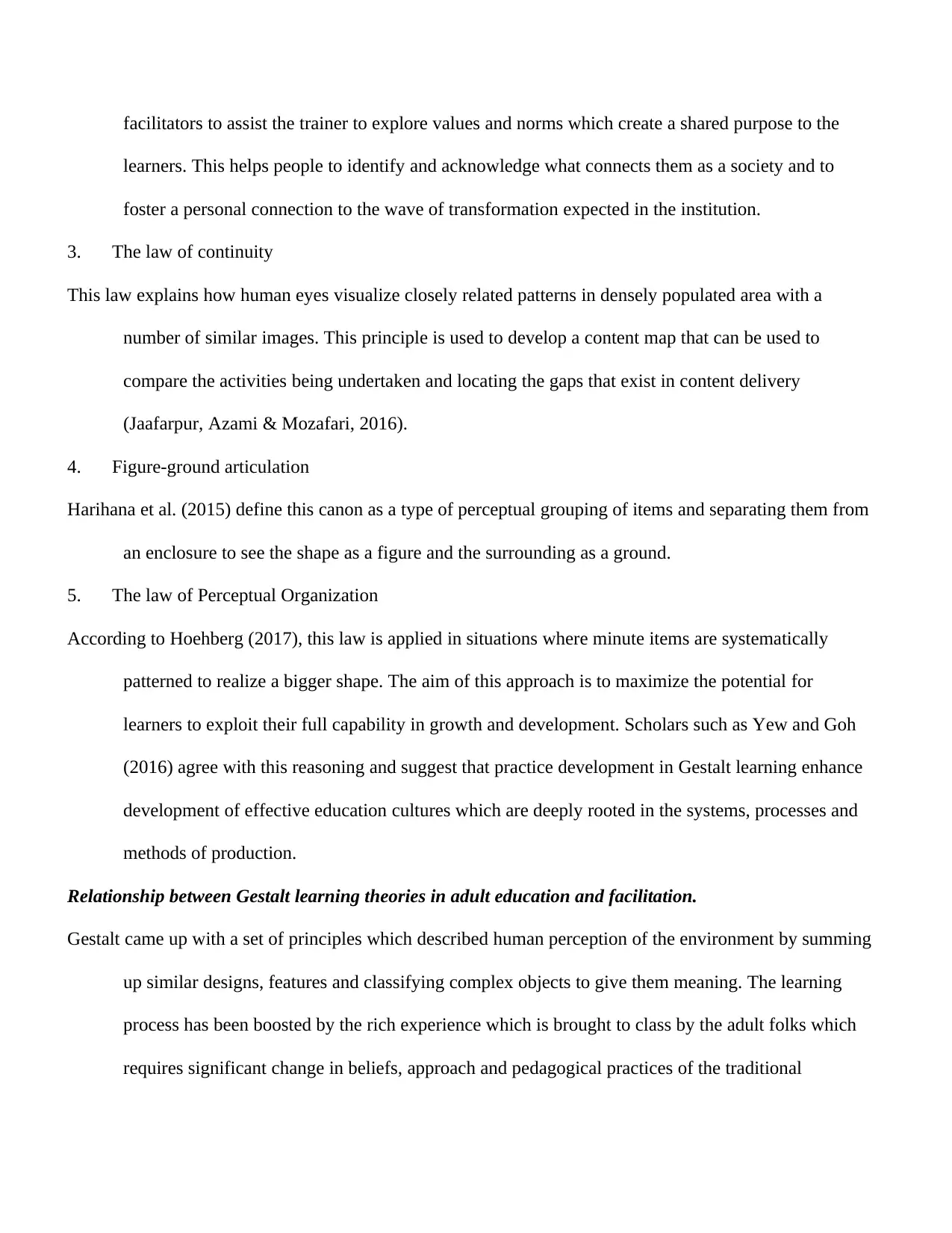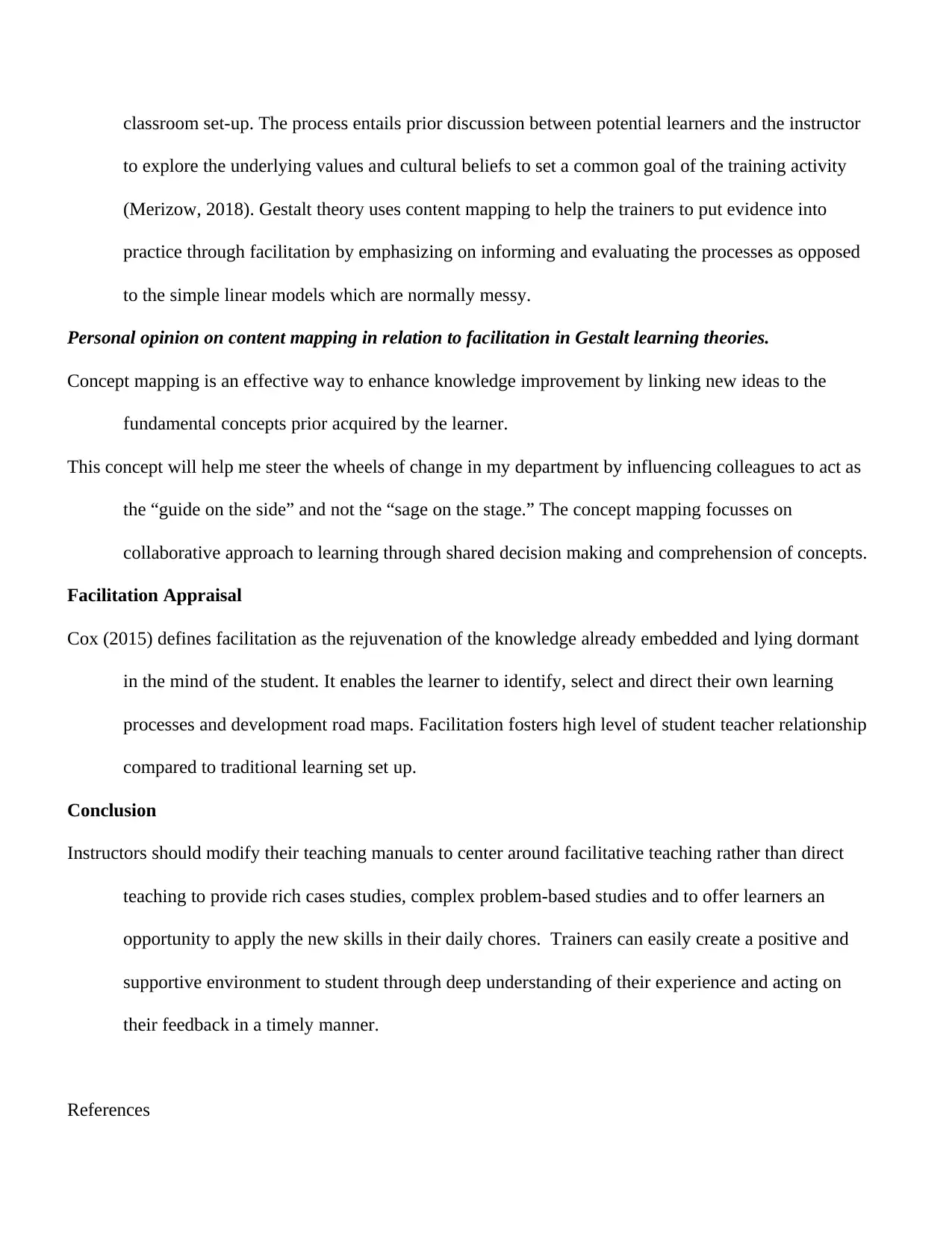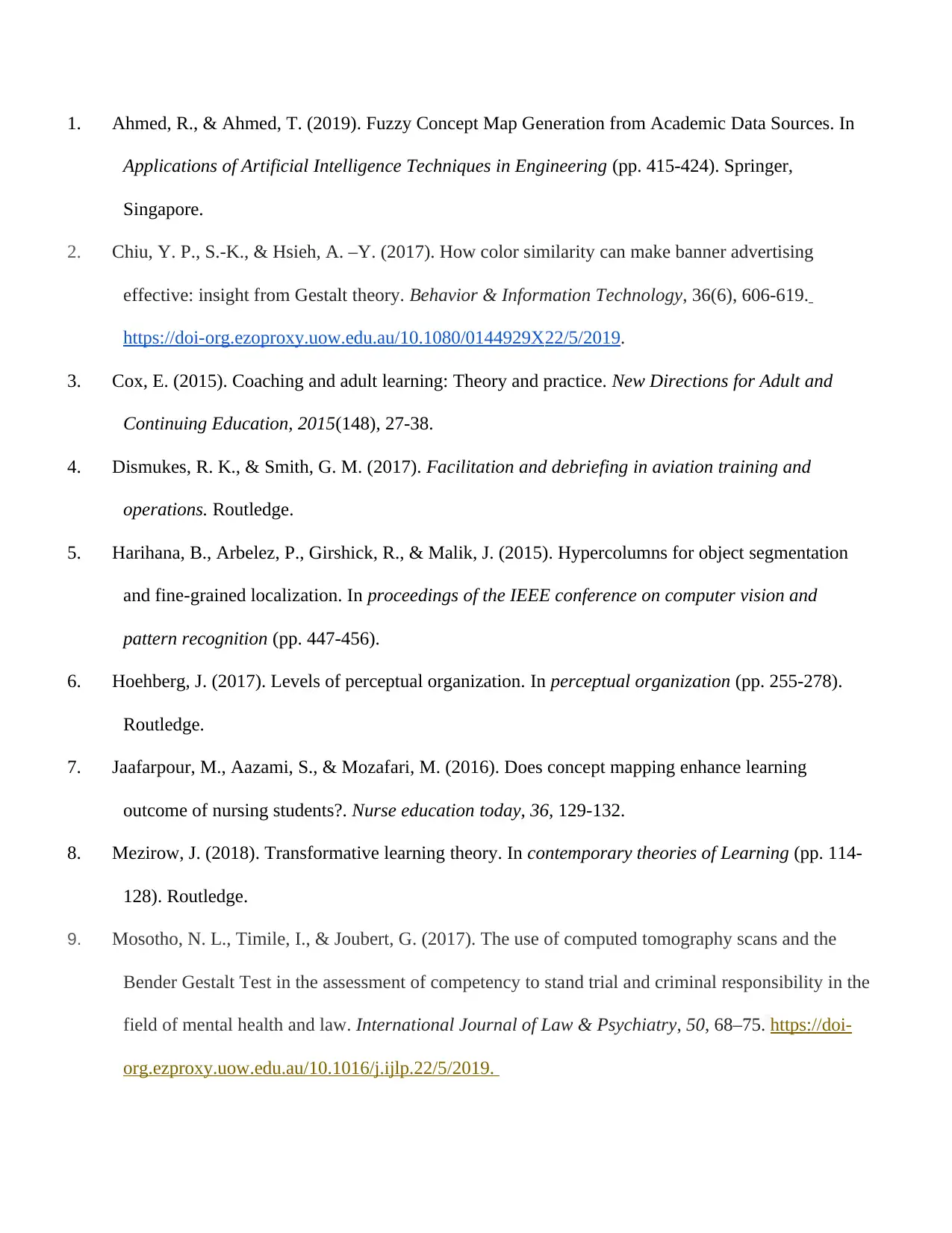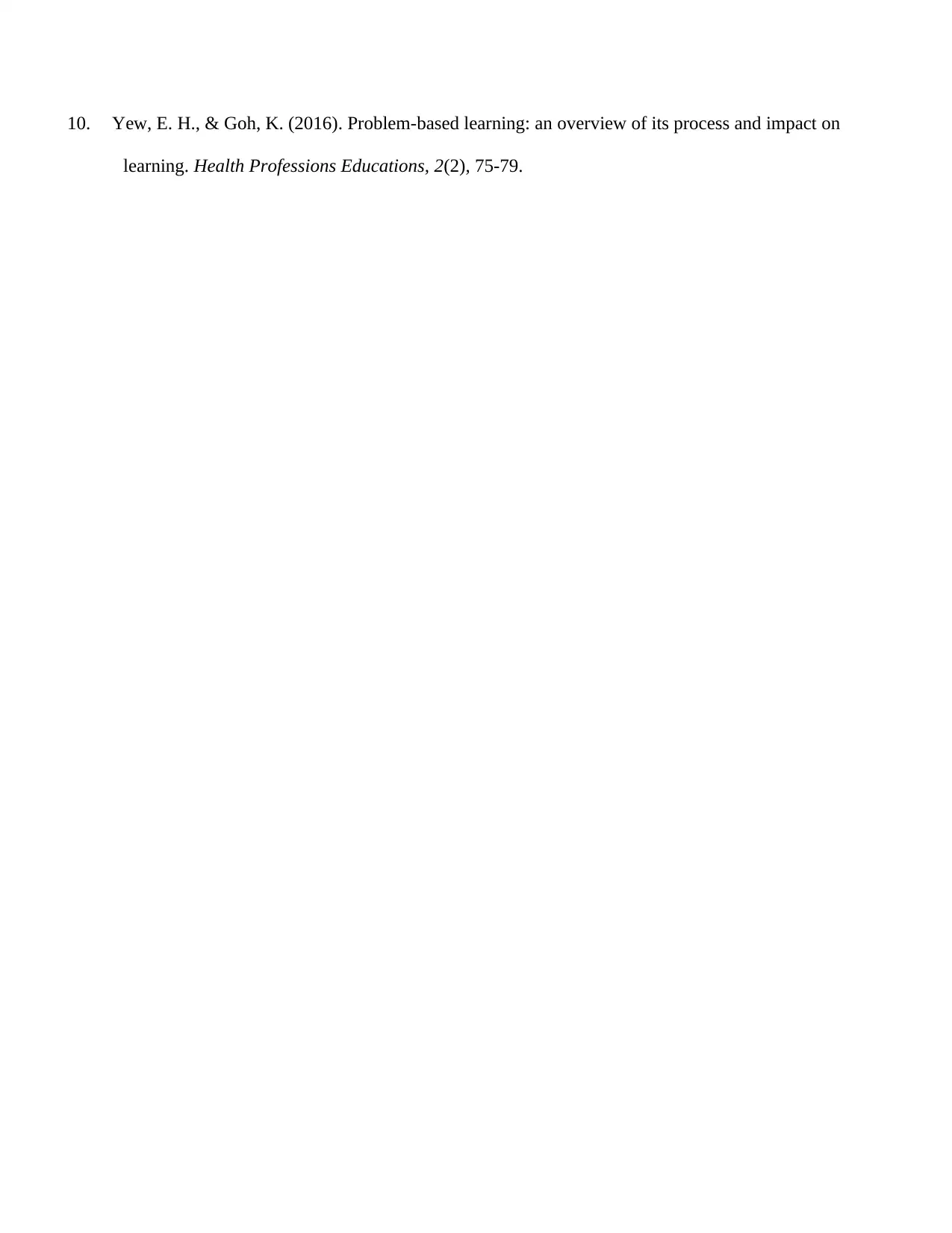Concept Mapping and Facilitation: A Gestalt Learning Analysis
VerifiedAdded on 2022/11/12
|6
|1355
|106
Report
AI Summary
This report delves into the application of concept mapping and facilitation within the context of Gestalt learning theory, particularly in adult education. It begins with an introduction to concept mapping, defining its role in structuring knowledge and its utility for learners and educators. The report then explores Gestalt learning theory, including its core principles such as reification, similarity, continuity, figure-ground articulation, and perceptual organization, and how these principles can inform and enhance facilitation methods. The study examines the relationship between Gestalt learning theories and facilitation in adult education, emphasizing the importance of incorporating learners' prior experiences and cultural beliefs. It also provides a personal opinion on the effectiveness of content mapping in enhancing knowledge and influencing teaching practices. Furthermore, the report discusses the role of facilitation in promoting student-teacher relationships and fostering a positive learning environment. The report concludes by recommending that instructors adopt facilitative teaching approaches to provide rich case studies, complex problem-based studies, and opportunities for learners to apply new skills. The provided references support the key concepts discussed throughout the report.

CONCEPT MAP AND REFLECTION
Introduction
A concept map is a pictorial presentation showing suggested relationships between ideas used by designers,
engineers as well as technical writers to structure and coordinate knowledge (Ahmed & Ahmad,
2019). Facilitation on the other hand is a teaching approach that seeks to assist learners to construct
meanings and comprehend ideas as well as processes (Dismukes & Smith, 2017). This study
examines speculations of visual discernment alluded to by the Gestalt theory of education.
Introduction
A concept map is a pictorial presentation showing suggested relationships between ideas used by designers,
engineers as well as technical writers to structure and coordinate knowledge (Ahmed & Ahmad,
2019). Facilitation on the other hand is a teaching approach that seeks to assist learners to construct
meanings and comprehend ideas as well as processes (Dismukes & Smith, 2017). This study
examines speculations of visual discernment alluded to by the Gestalt theory of education.
Paraphrase This Document
Need a fresh take? Get an instant paraphrase of this document with our AI Paraphraser

Objectives
The main objective of this study is to reflect content mapping with regards to theories of facilitation as a
method of teaching by examining outcomes and discussing various aspects of facilitation with a
focus on problem based learning.
Roles of the concept map
1. It plays the harmonization role of merging all the sources of knowledge to a common goal. The main
objective of this strategy is to create a shared vision throughout the learning program with a focus
on culture and its impact on the outcome.
2. Fosters understanding of relationship between the different concepts learnt by the student. This is
achieved through providing avenue for feedback delivery and actively engaging learners in the
training program as well as the evaluation phase.
3. Can help the learner to design new methods of acquiring knowledge through innovation and
inventiveness. As opposed to other approaches, it is concerned with delivery of quality services
with a deep focus on organizational change and innovation.
GESTALT LEARNING THEORY
CANONS OF GESTALT THEORY
1. Reification (the law of closure)
According to Mosotho et al. (2017), this law is exhibited by the existence of a missing between elements of
the same class hence one can only see the whole element by linking up the loose patches.
2. The law of similarity
According to Chiu et al. (2017), this principle is experienced when human eye perceives things as
appearing in the same class and forming a pattern. In this category, objects which have the same
visual characteristics are believed to be originating from the same class. This law is use by
The main objective of this study is to reflect content mapping with regards to theories of facilitation as a
method of teaching by examining outcomes and discussing various aspects of facilitation with a
focus on problem based learning.
Roles of the concept map
1. It plays the harmonization role of merging all the sources of knowledge to a common goal. The main
objective of this strategy is to create a shared vision throughout the learning program with a focus
on culture and its impact on the outcome.
2. Fosters understanding of relationship between the different concepts learnt by the student. This is
achieved through providing avenue for feedback delivery and actively engaging learners in the
training program as well as the evaluation phase.
3. Can help the learner to design new methods of acquiring knowledge through innovation and
inventiveness. As opposed to other approaches, it is concerned with delivery of quality services
with a deep focus on organizational change and innovation.
GESTALT LEARNING THEORY
CANONS OF GESTALT THEORY
1. Reification (the law of closure)
According to Mosotho et al. (2017), this law is exhibited by the existence of a missing between elements of
the same class hence one can only see the whole element by linking up the loose patches.
2. The law of similarity
According to Chiu et al. (2017), this principle is experienced when human eye perceives things as
appearing in the same class and forming a pattern. In this category, objects which have the same
visual characteristics are believed to be originating from the same class. This law is use by

facilitators to assist the trainer to explore values and norms which create a shared purpose to the
learners. This helps people to identify and acknowledge what connects them as a society and to
foster a personal connection to the wave of transformation expected in the institution.
3. The law of continuity
This law explains how human eyes visualize closely related patterns in densely populated area with a
number of similar images. This principle is used to develop a content map that can be used to
compare the activities being undertaken and locating the gaps that exist in content delivery
(Jaafarpur, Azami & Mozafari, 2016).
4. Figure-ground articulation
Harihana et al. (2015) define this canon as a type of perceptual grouping of items and separating them from
an enclosure to see the shape as a figure and the surrounding as a ground.
5. The law of Perceptual Organization
According to Hoehberg (2017), this law is applied in situations where minute items are systematically
patterned to realize a bigger shape. The aim of this approach is to maximize the potential for
learners to exploit their full capability in growth and development. Scholars such as Yew and Goh
(2016) agree with this reasoning and suggest that practice development in Gestalt learning enhance
development of effective education cultures which are deeply rooted in the systems, processes and
methods of production.
Relationship between Gestalt learning theories in adult education and facilitation.
Gestalt came up with a set of principles which described human perception of the environment by summing
up similar designs, features and classifying complex objects to give them meaning. The learning
process has been boosted by the rich experience which is brought to class by the adult folks which
requires significant change in beliefs, approach and pedagogical practices of the traditional
learners. This helps people to identify and acknowledge what connects them as a society and to
foster a personal connection to the wave of transformation expected in the institution.
3. The law of continuity
This law explains how human eyes visualize closely related patterns in densely populated area with a
number of similar images. This principle is used to develop a content map that can be used to
compare the activities being undertaken and locating the gaps that exist in content delivery
(Jaafarpur, Azami & Mozafari, 2016).
4. Figure-ground articulation
Harihana et al. (2015) define this canon as a type of perceptual grouping of items and separating them from
an enclosure to see the shape as a figure and the surrounding as a ground.
5. The law of Perceptual Organization
According to Hoehberg (2017), this law is applied in situations where minute items are systematically
patterned to realize a bigger shape. The aim of this approach is to maximize the potential for
learners to exploit their full capability in growth and development. Scholars such as Yew and Goh
(2016) agree with this reasoning and suggest that practice development in Gestalt learning enhance
development of effective education cultures which are deeply rooted in the systems, processes and
methods of production.
Relationship between Gestalt learning theories in adult education and facilitation.
Gestalt came up with a set of principles which described human perception of the environment by summing
up similar designs, features and classifying complex objects to give them meaning. The learning
process has been boosted by the rich experience which is brought to class by the adult folks which
requires significant change in beliefs, approach and pedagogical practices of the traditional
⊘ This is a preview!⊘
Do you want full access?
Subscribe today to unlock all pages.

Trusted by 1+ million students worldwide

classroom set-up. The process entails prior discussion between potential learners and the instructor
to explore the underlying values and cultural beliefs to set a common goal of the training activity
(Merizow, 2018). Gestalt theory uses content mapping to help the trainers to put evidence into
practice through facilitation by emphasizing on informing and evaluating the processes as opposed
to the simple linear models which are normally messy.
Personal opinion on content mapping in relation to facilitation in Gestalt learning theories.
Concept mapping is an effective way to enhance knowledge improvement by linking new ideas to the
fundamental concepts prior acquired by the learner.
This concept will help me steer the wheels of change in my department by influencing colleagues to act as
the “guide on the side” and not the “sage on the stage.” The concept mapping focusses on
collaborative approach to learning through shared decision making and comprehension of concepts.
Facilitation Appraisal
Cox (2015) defines facilitation as the rejuvenation of the knowledge already embedded and lying dormant
in the mind of the student. It enables the learner to identify, select and direct their own learning
processes and development road maps. Facilitation fosters high level of student teacher relationship
compared to traditional learning set up.
Conclusion
Instructors should modify their teaching manuals to center around facilitative teaching rather than direct
teaching to provide rich cases studies, complex problem-based studies and to offer learners an
opportunity to apply the new skills in their daily chores. Trainers can easily create a positive and
supportive environment to student through deep understanding of their experience and acting on
their feedback in a timely manner.
References
to explore the underlying values and cultural beliefs to set a common goal of the training activity
(Merizow, 2018). Gestalt theory uses content mapping to help the trainers to put evidence into
practice through facilitation by emphasizing on informing and evaluating the processes as opposed
to the simple linear models which are normally messy.
Personal opinion on content mapping in relation to facilitation in Gestalt learning theories.
Concept mapping is an effective way to enhance knowledge improvement by linking new ideas to the
fundamental concepts prior acquired by the learner.
This concept will help me steer the wheels of change in my department by influencing colleagues to act as
the “guide on the side” and not the “sage on the stage.” The concept mapping focusses on
collaborative approach to learning through shared decision making and comprehension of concepts.
Facilitation Appraisal
Cox (2015) defines facilitation as the rejuvenation of the knowledge already embedded and lying dormant
in the mind of the student. It enables the learner to identify, select and direct their own learning
processes and development road maps. Facilitation fosters high level of student teacher relationship
compared to traditional learning set up.
Conclusion
Instructors should modify their teaching manuals to center around facilitative teaching rather than direct
teaching to provide rich cases studies, complex problem-based studies and to offer learners an
opportunity to apply the new skills in their daily chores. Trainers can easily create a positive and
supportive environment to student through deep understanding of their experience and acting on
their feedback in a timely manner.
References
Paraphrase This Document
Need a fresh take? Get an instant paraphrase of this document with our AI Paraphraser

1. Ahmed, R., & Ahmed, T. (2019). Fuzzy Concept Map Generation from Academic Data Sources. In
Applications of Artificial Intelligence Techniques in Engineering (pp. 415-424). Springer,
Singapore.
2. Chiu, Y. P., S.-K., & Hsieh, A. –Y. (2017). How color similarity can make banner advertising
effective: insight from Gestalt theory. Behavior & Information Technology, 36(6), 606-619.
https://doi-org.ezoproxy.uow.edu.au/10.1080/0144929X22/5/2019.
3. Cox, E. (2015). Coaching and adult learning: Theory and practice. New Directions for Adult and
Continuing Education, 2015(148), 27-38.
4. Dismukes, R. K., & Smith, G. M. (2017). Facilitation and debriefing in aviation training and
operations. Routledge.
5. Harihana, B., Arbelez, P., Girshick, R., & Malik, J. (2015). Hypercolumns for object segmentation
and fine-grained localization. In proceedings of the IEEE conference on computer vision and
pattern recognition (pp. 447-456).
6. Hoehberg, J. (2017). Levels of perceptual organization. In perceptual organization (pp. 255-278).
Routledge.
7. Jaafarpour, M., Aazami, S., & Mozafari, M. (2016). Does concept mapping enhance learning
outcome of nursing students?. Nurse education today, 36, 129-132.
8. Mezirow, J. (2018). Transformative learning theory. In contemporary theories of Learning (pp. 114-
128). Routledge.
9. Mosotho, N. L., Timile, I., & Joubert, G. (2017). The use of computed tomography scans and the
Bender Gestalt Test in the assessment of competency to stand trial and criminal responsibility in the
field of mental health and law. International Journal of Law & Psychiatry, 50, 68–75. https://doi-
org.ezproxy.uow.edu.au/10.1016/j.ijlp.22/5/2019.
Applications of Artificial Intelligence Techniques in Engineering (pp. 415-424). Springer,
Singapore.
2. Chiu, Y. P., S.-K., & Hsieh, A. –Y. (2017). How color similarity can make banner advertising
effective: insight from Gestalt theory. Behavior & Information Technology, 36(6), 606-619.
https://doi-org.ezoproxy.uow.edu.au/10.1080/0144929X22/5/2019.
3. Cox, E. (2015). Coaching and adult learning: Theory and practice. New Directions for Adult and
Continuing Education, 2015(148), 27-38.
4. Dismukes, R. K., & Smith, G. M. (2017). Facilitation and debriefing in aviation training and
operations. Routledge.
5. Harihana, B., Arbelez, P., Girshick, R., & Malik, J. (2015). Hypercolumns for object segmentation
and fine-grained localization. In proceedings of the IEEE conference on computer vision and
pattern recognition (pp. 447-456).
6. Hoehberg, J. (2017). Levels of perceptual organization. In perceptual organization (pp. 255-278).
Routledge.
7. Jaafarpour, M., Aazami, S., & Mozafari, M. (2016). Does concept mapping enhance learning
outcome of nursing students?. Nurse education today, 36, 129-132.
8. Mezirow, J. (2018). Transformative learning theory. In contemporary theories of Learning (pp. 114-
128). Routledge.
9. Mosotho, N. L., Timile, I., & Joubert, G. (2017). The use of computed tomography scans and the
Bender Gestalt Test in the assessment of competency to stand trial and criminal responsibility in the
field of mental health and law. International Journal of Law & Psychiatry, 50, 68–75. https://doi-
org.ezproxy.uow.edu.au/10.1016/j.ijlp.22/5/2019.

10. Yew, E. H., & Goh, K. (2016). Problem-based learning: an overview of its process and impact on
learning. Health Professions Educations, 2(2), 75-79.
learning. Health Professions Educations, 2(2), 75-79.
⊘ This is a preview!⊘
Do you want full access?
Subscribe today to unlock all pages.

Trusted by 1+ million students worldwide
1 out of 6
Related Documents
Your All-in-One AI-Powered Toolkit for Academic Success.
+13062052269
info@desklib.com
Available 24*7 on WhatsApp / Email
![[object Object]](/_next/static/media/star-bottom.7253800d.svg)
Unlock your academic potential
Copyright © 2020–2025 A2Z Services. All Rights Reserved. Developed and managed by ZUCOL.



